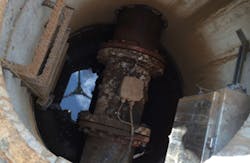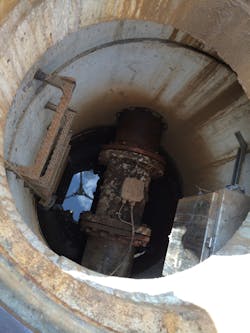Battery-operated capability is enabling magnetic flowmeter technology to be employed in various new applications where direct wiring is difficult, such as the water distribution monitoring system pictured here. (Photo courtesy of Siemens Industry Inc.)
Revenue from magnetic flowmeters exceeds revenue from all other flowmeter types, including Coriolis, positive-displacement (PD), turbine, and differential pressure (DP) meters. The story is somewhat different in terms of units, however. More DP and variable-area flowmeters are sold annually than magnetic flowmeters. Despite this, the higher average selling price of magnetic flowmeters enables them to generate more revenue annually than these other types of meters.
Multiple factors currently drive magnetic meters to be the top revenue-producing meter. A steady stream of new products has kept the magnetic flowmeter market vibrant with growth. The development of insertion meters gives more options to end-users who may hesitate to pay the high prices for large line size magnetic flowmeters. Suppliers have brought out a wide variety of liners to handle sanitary and caustic liquids. Advanced diagnostics are making magnetic flowmeters both more intelligent and more reliable. And water flow measurement is increasingly important as populations increase and water shortages become more common.
Most flowmeters do their best work in clean liquids or gases. This is true, for example, of turbine, Coriolis, ultrasonic transit-time, and vortex meters. Magnetic flowmeters, by contrast, thrive in measuring dirty liquids. Magnetic flowmeters and Doppler ultrasonic meters are the only two of the main types of meters that do well in dirty and impure liquids, although DP meters can also measure dirty liquids if they have the right kind of primary element. Magnetic flowmeters are used to measure the flow of conductive liquids and slurries, including pulp and paper slurries and black liquor. Their main limitation is that they cannot measure hydrocarbons (which are nonconductive), and, hence, are not widely used in the petroleum industry.
READ ALSO:
- Energy and Large-Pipe Applications Drive Coriolis Technology to New Heights
- Differential Pressure Maintains a Powerful Place in the World of Flow Measurement
- PD Flowmeters Poised to Gain from Oil & Gas Application Opportunities
- Emissions Monitoring Applications Propel Thermal Flowmeter Market
- Turbine Flowmeters Remain Competitive in Turbulent Market
- Custody-Transfer Applications Drive Ultrasonic Flowmeter Growth
- Vortex Flowmeters Prove Their Worth In Steam Flow Measurement
While the magnetic flowmeter market is a mature and stable one, there are some new product developments that favor continued growth. One recent development is the advent of two-wire magnetic flowmeters. Four-wire meters have a dedicated power supply. Two-wire meters use the power available from the loop-power supply, which reduces wiring costs and can result in lower installation costs. These meters are becoming more popular with users due to the cost savings involved. While two-wire meters still represent only a small percentage of the total magnetic flowmeters sold, their use grew significantly from 2008 to 2013.
Another important development is growth in battery-operated and wireless magnetic flowmeters. Battery-operated meters make it possible to install magnetic flowmeters in hard-to-reach places; and wireless meters can transmit a receivable signal where the use of wires is impractical. Both of these segments represent fast-growing areas of the magnetic flowmeter market.
Magnetic flowmeters are widely used in the process industries, such as chemical, food & beverage, pharmaceutical, pulp & paper, and water & wastewater. Magnetic flowmeters will increasingly be seen as an alternative to differential-pressure flowmeters. They are widely used in the food & beverage and pharmaceutical industries, where special liners enable them to be used in sanitary conditions. Some 29 percent of magnetic flowmeter revenues are from sales to the water & wastewater industry, which has the highest percentage of magnetic flowmeter sales of any of the process industries.
For information on magnetic flowmeters, visit www.flowmags.com.



